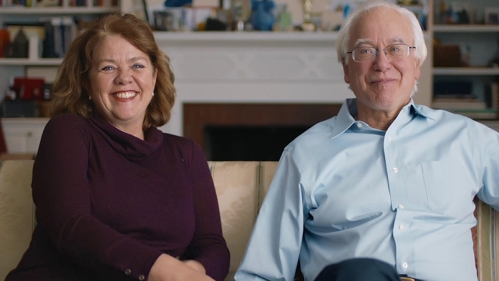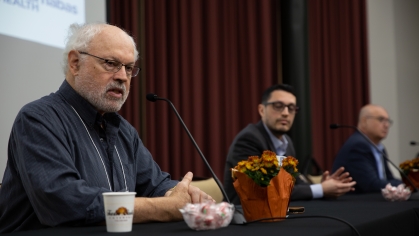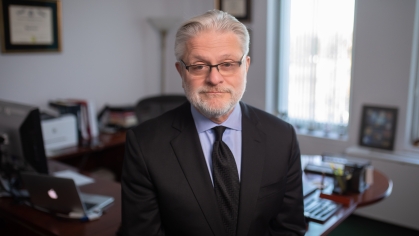“The Invisible Extinction” to Be Screened at Rutgers Day

Pioneering microbiome researchers Martin Blaser and Maria Gloria Dominguez-Bello provide an inside look at their film
For decades, microbiologists Martin Blaser and Maria Gloria Dominguez-Bello have researched the link between the human body’s microbiome – the bacteria, fungi and viruses that help us digest food and keep us healthy – and their link to diseases such as diabetes, asthma and autism.

The married couple, subjects of the documentary The Invisible Extinction, which chronicles this calamity and follows Blaser, director of the Center for Advanced Biotechnology and Medicine at Rutgers Biomedical and Health Sciences, and Dominguez-Bello, the Henry Rutgers Professor of Microbiome and Health at the Rutgers School of Environmental and Biological Sciences, as they travel the world in search of answers.
The two will host a question-and-answer session on their research following screenings of the 80-minute film at noon and 2 p.m. Saturday, April 29, during Rutgers Day in the Busch Student Center, 604 Bartholomew Road, Piscataway.
Blaser and Dominguez-Bello discuss their research, the importance of protecting our microbiome and the potential power of restoring lost microbiome diversity, chronicled in their work from New Jersey to Switzerland building the Microbiota Vault to preserve human microbial diversity.
Why is the microbiome important?
Blaser: The human microbiome includes the trillions of microscopic organisms that live on and in our bodies, contributing to our health in many ways. We have long known that we have microbes in our gut, but there has been a scientific revolution over the last 20 years that has made us realize how important the microbes that live in and on the human body are to human health. We are beginning to understand how diseases that have been rising in recent years – obesity, diabetes, asthma, allergies, inflammatory bowel disease and even some cancers – are linked to the damaging of our microbiome.
What are the threats to the microbiome?
Blaser: There is evidence that we have been losing our ancestral organisms due to our use of anti-microbials, such as those in food or antibiotics, which destroy the beneficial microbes as well, or due to the increase in births by C-section, to give the two best examples. When a child is born vaginally, the mother’s microbiome is passed to the baby, but this natural transfer is lost during a C-section.
What insight into your work does the film provide?
Dominguez-Bello: The film humanizes the science. The directors successfully portray the humanity of the scientists and patients, including their families and the problems they face. People will see the challenges to conducting research. They will see how important the microbiome is and why they should be concerned about the over-use of antibiotics, along with elective C-sections and the consumption of too many processed foods, which is damaging our microbiome, reducing beneficial germs and creating a hidden health crisis.
Blaser: Although the film tracks us around the world, this issue is not about one country or another. It’s about parents with kids who have autism or patients with illnesses linked to microbial health. It’s about people concerned about preventing illnesses in their children and grandchildren. As researchers, we’re seeking solutions across borders; the themes are universal.
The film gives an exclusive glimpse at the Microbiota Vault. Why is this collection essential?
Blaser: We are in a race against time and face an extinction crisis. It’s invisible, it’s deadly and it’s happening in all of us right now. Not unlike the planetary disaster that is climate change, if we don’t move quickly to protect and preserve the diverse microbiome of our ancestors, these helpful organisms will be lost forever.
Dominguez-Bello: Over the last 70 years, due to environmental factors including antibiotic use, we see a reduction of about 50 percent in our microbial diversity, compared with South American Amerindians living traditional lives. High microbial diversity is deemed important in regulating immune system responses and digesting food. Scientists believe that this decline in microbial diversity is driving the surge in chronic illnesses.
Local collections around the world are gathering microbiomes, of which those uncompromised by antibiotics, processed diets and other ill effects of modern society will lead scientists to identify the beneficial germs. We need living microbes for the future restoration of the microbiota. Fortunately, microbes can be frozen and preserved live. This is crucial, while science investigates how to restore the diversity of microbes that are decreasing. Meanwhile, the Microbiota Vault wants to offer local collections a safe place for backups.
What else will people learn from The Invisible Extinction?
Blaser: The film gives an inside look on how science works, the scientific process of discovery – especially in relation to human health – how clinical trials are conducted and why placebos are important. The film has its share of surprises and surprise endings.
We are excited to share this film about science, which is taking place at Rutgers. As the main characters in the film, we are looking forward to helping to answer the public’s questions about our research, the process of filming a movie about science and making science accessible to the public.



